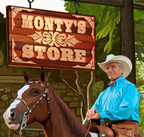How do you stop your horse from napping, i.e refusing to go first out on a hack until the moment we turn around and head for home.
Rewards
Subscribe to Equus Online University and become a part of Monty's worldwide mission to leave the world a better place for horses and for people too.
Students automatically gain access to special rewards, such as exclusive discounts at the Monty Roberts Online Shop. Visit Monty Roberts Online Shop.




I found this on the Q&As:
04/23/08: I have a 6 year old gelding, Geronimo, who is very much the dominant one in my small heard of three geldings. Everyone gets on fine at home as they know what the pecking order is. My problem is when I take Geronimo out in public. When we are standing around, waiting for our turn at an event, if there is a horse within 10 feet or so behind Geronimo he will begin backing up in order to bump in to the other horse. The only way I can stop him is by turning him to face the horse or spurring him to move forward. A simple leg squeeze will not suffice when he is on this mission. I can avoid the situation by being careful of who is around me, or simply ‘hiding’ in a corner, but I would really like to cure him of the habit.
Monty’s Answer: This is an interesting question and one that is quite unique. I have seen this phenomenon occur many times in my life. The problem that I have viewed has been present in riding schools and rent stables almost exclusively. It is more prevalent when riders have very little experience and the horses are able to take advantage of that fact.
I suggest that you treat this remedial behavior in the same way that I recommend for balking or barn sour horses. This behavior is also called napping in England. There are three chapters in my book From My Hands To Yours which deal with similar behavior, balking, barn sour and separation anxiety. I recommend reading all three of those chapters if you have the book.
To put my recommendation in capsule form, what I suggest is the use of blinkers so that the horse does not see behind him. I then recommend the use of the Giddy Up rope (called a wip wop in England). One can easily make one and it is fully described in From My Hands To Yours. The Giddy Up rope is made from yarn, cotton or a soft rope material. One makes it in such a way that it is about 3 feet long (one meter) with a loop at one end for your wrist and tied in such a way so that you leave a tassel of about 8 inches at the other end.
The Giddy Up rope will produce no pain but when used in conjunction with blinkers it will encourage forward motion more effectively than anything else I could recommend. With all of these measures in place one should wait for the problem to occur and then swing the Giddy Up rope back and forth in front of yourself allowing it to meet the horse’ s sides just behind your legs. Generally two or three contact impacts are sufficient for each schooling episode. Your horse should immediately move forward and cooperate with you instead of considering his negative activity.
Repeat this effort several times during the course of any riding session and I think you will be amazed with any results. Gradually you can remove the blinkers and eventually you won’t even need the Giddy Up rope. Do not reduce to pain-producing whips, as they will simply have you sending in another question about another problem they have created which may well be unrelated to the current problem.